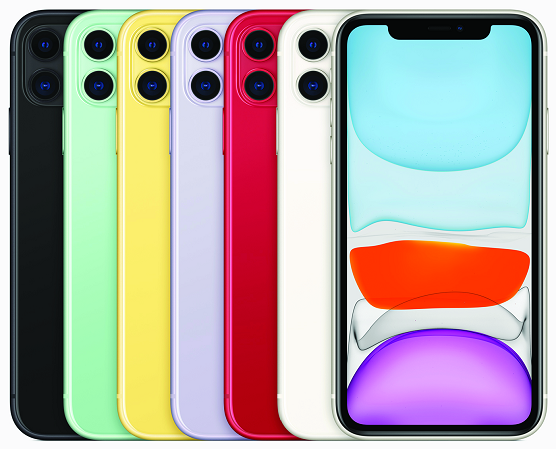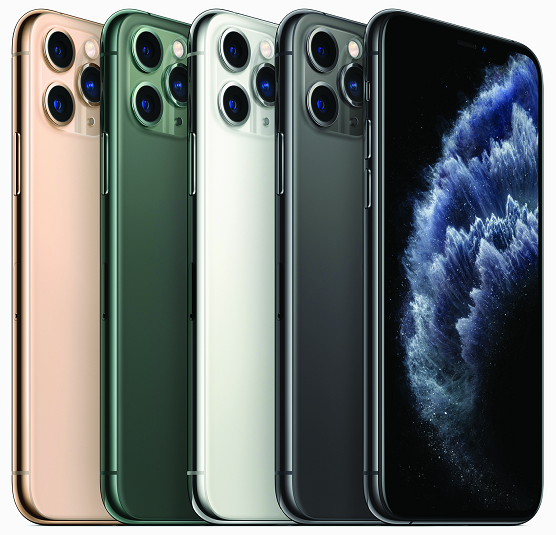Apple’s latest additions to the iPhone family are the iPhone 11, 11 Pro, and 11 Pro Max. Like their predecessors, they are highly advanced smartphones that leave competitors in the dust. They also signal that Apple has no plans to include the Home button in future models, which is something seasoned iPhone X and newer model users have come to embrace. Here are some of the key features of the latest iPhone models:
- An A13 chip: Each of the three new iPhone models includes the new A13 chip. The truly innovative tech in these models demands a processor that can handle some heavy lifting while still being able to answer calls and retrieve email.
- Dual SIM technology (nano-SIMs and eSIMs): These newest iPhone models support the use of both nano-SIMs and eSIMS. Every cell phone uses a chip called a SIM that allows it to work with cellular networks. Traditionally, SIMs (which are nano-SIMs in the iPhone 11, 11 Pro, and 11 Pro Max) are small cards installed in your iPhone by you or your cellular provider. The use of SIMs makes switching providers a bit of an ordeal because each SIM is wired for only a specific network.However, eSIMs are chips embedded into your iPhone that will never need to be changed out and are compatible with any provider, allowing you to easily switch cellular providers by scanning a code or using an app from your cellular provider. You’ll want to discuss this option with your cellular provider when your purchase a new iPhone model. Other benefits of dual SIMS are that you can have more than one number on your iPhone (perhaps one could be personal and the other for work); you’re able to more easily add local plans when you travel; and you can even have separate voice and data plans.
- Splash, water, and dust resistance: Your new iPhone 11, 11 Pro, or 11 Pro Max is resistant to damage caused by water splashing onto it or from dust collecting within it.
You might consider acquiring AppleCare+, which is Apple’s extended warranty, currently priced at $149 for iPhone 11, or $199 for iPhone 11 Pro and 11 Pro Max. AppleCare+ does cover up to two incidents of accidental damage, which could more than cover the cost of repairing your iPhone without it. You can also get AppleCare+ with Theft and Loss coverage for $100 more, regardless of the model.
Now, you don’t want to take your iPhone 11 Pro or 11 Pro Max deep-sea diving, but it’s likely to survive submersion in about four meters of water for up to 30 minutes. The iPhone 11 is rated at about two meters of water for up to 30 minutes. Mind you, these numbers have been tested in labs and aren't based on real-world conditions. In other words, if your iPhone 11 model gets wet, it’s much more likely to survive the ordeal than older iPhone iterations, but it still isn't something you’d like to see happen to your expensive investment.
- Glass body and wireless charging: iPhone 11 models are comprised of an all-glass body (with a tiny sliver of stainless steel around the edges to hold it all together), allowing a beautiful appearance and wireless charging. The glass is also the most durable of that used in any smartphone ever, according to Apple.
Don’t read that as unbreakable. Cases are still a good — no, make that a great — idea. As a matter of fact, Apple has a line of cases that not only protect your iPhone but also allow for wireless charging.
- Edge-to-Edge display: iPhone 11 models sport edge-to-edge displays, meaning there’s nothing else on the front of your iPhone but screen.
- No Home button: The method you’ve used for a decade now to return to the Home screen is now a thing of the past with iPhone X and newer models. You simply swipe up from the bottom of the screen to provide the same effect as pressing the Home button. This also means that Touch ID as an unlocking method is now relegated to older iPhones.
- Facial Recognition: Touch ID is replaced on iPhone X models and newer with Face ID. Using Face ID and the front-facing camera, your iPhone 11 model unlocks when it recognizes your face.
- Performance enhancements: Apple promises that iOS 13 will increase the speed and performance of your iPhone, going all the way back as far as iPhone SE. From apps to keyboards to taking pictures – everything gets a speed upgrade.
- Siri improvements: Siri just keeps getting better. Siri can now speak in more natural tones and cadence, thanks to new software rendering capabilities. Siri can also give you more personalized information, including being able to find event information and reminders in other apps. And Siri can now play audio files from third-party app providers.
- Dark Mode has arrived: With iOS 13, you have the option of using Dark Mode, which gives the iOS color scheme from light to dark. Dark Mode is especially helpful in low-light situations, or when you don’t want to disturb others with the bright light from your iPhone’s screen.
- Accessibility enhancements: Voice Control allows you to control your iPhone entirely with your voice; dictation is much more accurate; processing of voice commands happens right on your iPhone (as opposed to being transmitted to an online location and then returned to your iPhone); Numbers and Grids help to make more accurate selections; and the list goes on.
- Upgrades to Photos: The Photos app receives some love in iOS 13, allowing for faster and more accurate searches of your Photos Library, better organization, better filters, enhanced and non-
- All new Maps: iOS 13 introduces the new Maps app, which has been completely reconstructed and comes loaded with amazing features and awesome attention to landmark details. Junction View helps make sure you’re in the right lane for turns, but the Look Around feature is worth the price of admission alone. Look Around lets you see a 360-degree three-dimensional view of locations, enabling you to know your way around before you even get there.
Don’t need or use all the built-in apps? You can remove them from your Home screen. When you remove a built-in app from your Home screen, you aren't deleting it — you’re hiding it. This is due to security reasons. However, the built-in apps take up very little of your iPhone’s storage space, and they can easily be added back to your Home screen by searching for them in the App Store and tapping the Get button.
These are but a very few of the improvements made to the latest version of iOS. Visit Apple’s website to find out more.Choosing the right iPhone 11 for you
The sizes of the latest iPhone 11 models vary:- iPhone 11 measures 2.98” by 5.94” (6.1” diagonally) with a depth of .33 inches.
 Image courtesy of Apple, Inc.
Image courtesy of Apple, Inc. - iPhone 11 Pro measures 2.81” by 5.67” (5.8” diagonally) with a depth of .32 inches.
 Image courtesy of Apple, Inc.
Image courtesy of Apple, Inc. - iPhone 11 Pro Max measures 3.06” by 6.22” (6.5” diagonally) with a depth of .32 inches.
Other differences between iPhone X models come primarily from the current operating system, iOS 13.
Not sure whether to get an iPhone 11 model? Here are a few more key differences:
- The battery life of the iPhone 11 Pro Max is longer than the 11 or 11 pro. For example, audio playback time on the 11 Pro Max is rated at 80 hours versus 65 hours on the 11 and 11 Pro.
- iPhone 11 Pro and 11 Pro Max have triple rear-facing cameras, providing amazing optical zoom, Portrait mode, and other features. The 11 has dual rear-facing cameras.
- Screen resolution: The higher the resolution, the crisper the phone display. The iPhone 11 provides 1792 x 828 resolution; 11 Pro provides 2436 x 1125; and 11 Pro Max provides a stunning 2688 x 1242.
| Model | Storage | Cost (may vary by carrier) | Carriers |
| 8 | 64 and 128GB | from $449 | AT&T, Verizon, Sprint, T-Mobile |
| 8 Plus | 64 and 128GB | from $549 | AT&T, Verizon, Sprint, T-Mobile |
| XR | 64 and 128GB | from $599 | AT&T, Verizon, Sprint, T-Mobile |
| 11 | 64, 128, and 256GB | from $699 | AT&T, Verizon, Sprint, T-Mobile |
| 11 Pro | 64, 256GB, and 512GB | from $999 | AT&T, Verizon, Sprint, T-Mobile |
| 11 Pro Max | 64, 256GB, and 512GB | from $1099 | AT&T, Verizon, Sprint, T-Mobile |
One exciting pricing option is the iPhone Upgrade Program. You choose your carrier, get an unlocked phone so you can change carriers, and receive Apple Care + to cover you in case your phone has problems, all starting at a cost of $37.41 a month (depending on the iPhone model you select). Data usage from your carrier will come on top of that. Check out Apple's Upgrade Program for more information.

